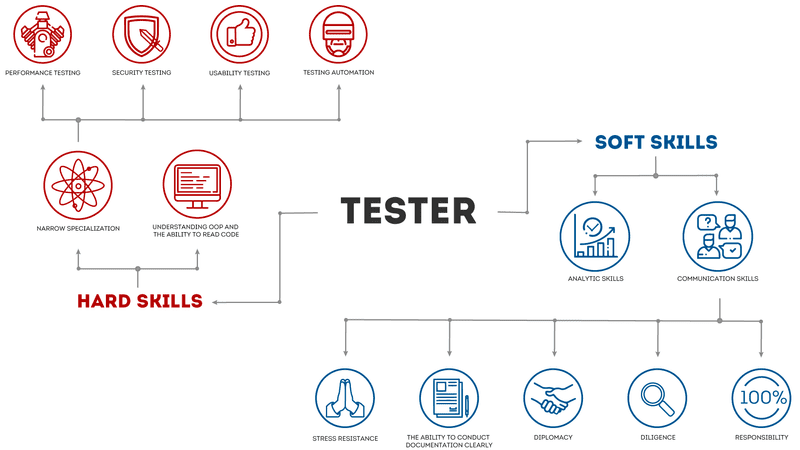Who Is a Tester?
READ WHOLE ARTICLE

Tester is a common profession in the modern IT world. It is great for those who are good at Information Technology at school and have critical thinking, systemic vision, can clearly define causality and formulate the thoughts.
There is an opinion that becoming a tester is one of the easiest ways to get into IT, and everybody is capable of it: from the tractor driver to the high school graduate. But, of course, everything is not so simple. To become a master in such profession, you need technical training and a specific set of soft and hard skills. If you want to find out what the work of the tester is, and what we would advise to pay attention to for those who want to succeed in this field – read on.
Tester description
In addition to soft skills, a very important point for a tester is the ability to accurately reproduce, formulate and describe in detail the problems found, indicating necessary and sufficient steps, test data and links, as well as attach screenshots, videos and logs. At the same time you need to be able to work with the documentation, and in its absence, be guided by common sense.
The tester should be able to correctly describe the “inadequate behavior” of the system.

Testing methods
We are not going to talk about the theory of testing, but note that its knowledge is very important, and you should not be fooled by expectations that it is possible to work without them. Instead, we have compiled our list of the best ways to find an error in an analysed product:
- Imagine that you are a regular user and perform real actions in the system and only then proceed to alternative (negative) scenarios.
- Use the console to help find and identify errors in web applications.
- Refresh the page and check if its appearance has changed. It happens that after the update, the page breaks.
- Try to interact even with inactive elements (clicking on inactive buttons and links).
- Check the processing of the entered data in all fields in various combinations (text, numbers, calendars, check-boxes, drop-down lists, etc.).
- Check everything in at least two different browsers (and definitely in those that users utilize)
- Change test scripts and input data.
- Check the script from start to finish and even more, because sometimes we are step away from the bug.
- Change the screen size of the device (browser screen width, aspect ratio, etc.).
Questions are really important
The tester shouldn’t be ashamed to ask questions, it is important to remember that the main goal is to get correct and accurate information.
List of sample (frequent) updates:
- clarification of incomprehensible terms in the documentation;
- clarification of implicitly prescribed logic of the system;
- clarification of the obviously unregistered (missing) logic of the system operation;
- clarification of the contradictory prescribed logic of the system;
- clarifying whether the observed behavior of the system is a bug, features or minor inaccuracies, which in today’s realities can be ignored;
- clarification whether a previously detected inappropriate behavior of the system was described somewhere (if there is a defect about this, or a task for revision, or is it noted in the technical documentation as acceptable behavior);
- clarifying who exactly can solve the question that appeared to the tester;
- clarifying who is responsible for solving the problem and how to pass the relevant information to these individuals, and what information should be given to them.
Also, asking the question, the tester should do it in such form as that the respondent has a desire to answer the question, which means necessarily a polite form and the availability of information in the given topic which the tester could find on his own. However, you shouldn’t spend all your time and energy on an independent search for answers to questions, yet there is a reasonable limit.
And if nothing or too little information was found on your own, it would be a good decision to stop in time, smile to the programmer and ask him for help:)
System approach to testing
The system approach aims to test the relationships between components and their interaction with different parts of the system. First we go the way
which is divided into modules. We test the operation of a module or component separately. At this stage, we can detect the main errors associated with the functionality of individual features.
At the next stage, we test the functionality that is connected together, go through the testing path. This step helps to determine the readiness of the application.
It is important to go all the way from the beginning to the end, not forgetting about every necessary step, often errors and bugs occur on the finish line.
Curiosity and attention to detail
An important feature that is required by any tester is curiosity. Anyone who doesn’t possess this quality will not be able to fully test any system.
He will be able to pass test cases written by someone else and cause defects that anyone could identify in his place. In addition to passing, it is very important to deviate from clear and well-thought-out scenarios: most often during Ad hoc testing, where nobody expects to find, unfortunate bugs appear.
In fact, the developers themselves are inclined to check their work, and so they follow the standard scenarios, and testers also need to go beyond, think differently, and always keep in mind the question: “What if …?” This will add a lot of your productivity work. The main thing to believe and know that mistakes are everywhere and that it is YOU who is able to prevent the ill-fated “CRASH” and fulfill your big small mission.
Final Words
You need to be a cheerful fellow, who will try to improve the life of humanity, no matter how trite and loud it sounds. To be an assistant to all team members (from the manager to the developer), and even the client’s best friend, defend his interests, understand and feel exactly how he wants the product to be made, and share your advice based on personal experience, how best to act in a given technical situation. Except the attention to detail, you must have a sense of humor and have a great stress tolerance to periodic dissatisfaction in your address (as in any other profession of the IT industry), and defend your point of view through arguments understandable to the interlocutor.

36 Kings Road
CM1 4HP Chelmsford
England


